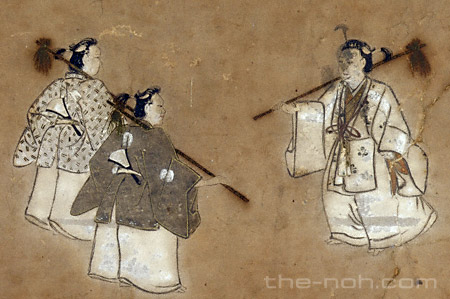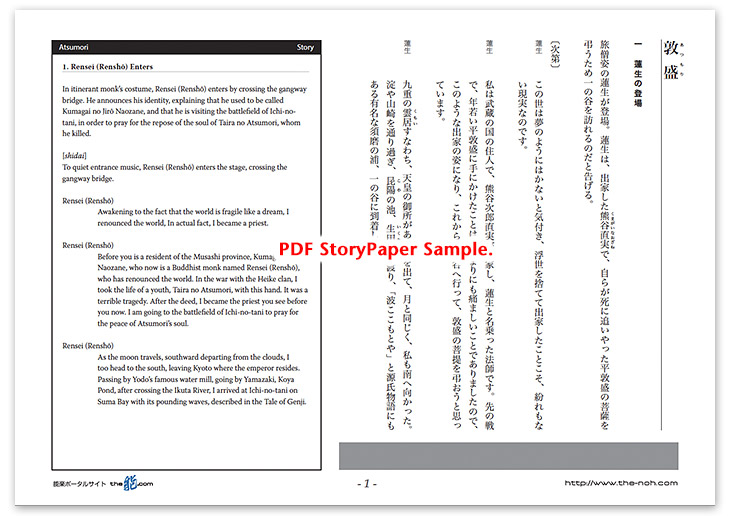
 Atsumori
Atsumori

![]()
After killing the exceptionally young warrior, Taira no Atsumori, in the battle at Ichi-no-tani, Kumagai no Jirō Naozane, a warrior of the Genji clan, renounced the world and took the priestly name Rensei (Renshō), as he was overwhelmed by the tragedy and realized the uncertainty of life. When Rensei (Renshō) visits the Ichi-no-tani battlefield to pray for the repose of Atsumori's soul and looks back on the day, grass cutters appear, to the music of a flute. When Rensei (Renshō) speaks to them, one of them tells him the story associated with the flute.
To the suspicious Rensei (Renshō), the man responds that he has a connection with Atsumori and asks Rensei (Renshō) to repeat the prayer to Amitabha Buddha ten times for the sake of Atsumori. When Rensei (Renshō) recites the sutra connected with Amitabha Tathagata, the man implies that he is the ghost of Atsumori and disappears.
In the night, the ghost of Atsumori, who looks as he was on his last day, appears before Rensei (Renshō), who prays for the peace of Atumori's soul. Atsumori is delighted as Rensei (Renshō), who prays for salvation through mourning Atsumori, was a foe but is a true friend now. Atsumori then starts to confess. First, in the kuse he describes the Heike clan's escape from Kyoto in the autumn of 1183, their forlorn lives in Suma Bay, and the decline of the entire clan. He then dances while recalling the party in the Ichi-no-tani camp in the last night of his life. He shows the past battle scene in which Atsumori came to the beach at Ichi-no-tani to embark on a boat, but Kumagai called after him to challenge him to single combat. Atsumori leaves asking Rensei (Renshō), whom he feels like not an enemy but a close friend, to pray for his soul.
![]()
Taira no Atsumori was a beautiful sixteen-year-old at the time of the battle at Ichi-no-tani. His beauty is even extolled in the Tale of the Heike. He is sometimes called “Tayū (an official of the fifth rank) without a position" as he was not assigned any government position despite of his rank of ju-goi-no-ge (lower grade of the junior fifth rank). Atsumori was an expert on the Japanese flute. He possessed a great flute called “Saeda," which was given to his grandfather, Tadamori, from the Ex-emperor Toba and was inherited from his father, Tsunemori. Atsumori, who was rather a young aristocrat of the Heian period than a warrior, met and fought with Kumagai no Naozane, who was a rough warrior from the rural Eastern Province. The Tale of the Heike describes their encounter in which Kumagai hesitated for a moment to stab on Atsumori's neck since the youth was so beautiful and Kumagai did not know which part of such a beautiful body he should cut.
Zeami does not describe the conflicts within Kumagai's heart in this noh drama, but rather focuses on his sentiment in becoming a priest encouraged by this incident. Zeami constructs his plot such that two foes became true friends owing to the providence of the Buddha.
STORY PAPER : Atsumori
Story Paper presents noh chant stories in modern speech, with story outlines, highlights and more using Adobe PDF format, which can print out and zoom in. Print out the pages and take them with you when you see the actual noh performance.

The copyright of Story Paper is held by the Noh.com. Story Paper is for individual use only. It is prohibited by the copyright law to distribute or publish printed-out Story Paper pages without prior consent. For more information, check the credit and disclaimer pages.



 [Atsumori : Story Paper PDF : 574KB
[Atsumori : Story Paper PDF : 574KB